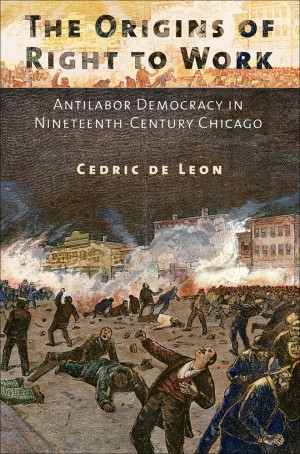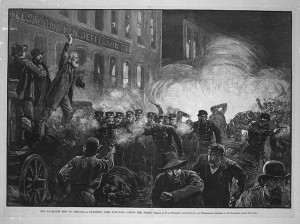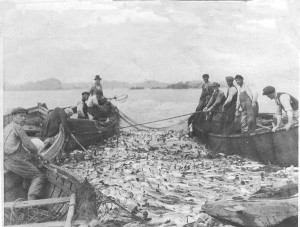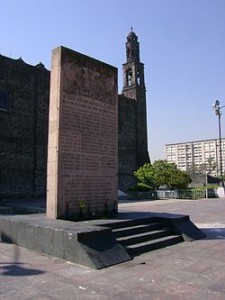
For the last several years, I have written in various forums about how the United States has entered a New Gilded Age. That is, through decimating workers’ rights and empowering corporations to dominate the political system, we are recreating the Gilded Age of the late nineteenth and early twentieth centuries. That period was noted by its incredible levels of income inequality, by the state using the military to crush strikes, by plutocrats buying off politicians with cash and illegal stock trading schemes, by economic collapses because of unregulated corporate behavior, and by a lack of regulations that allowed corporations to kill workers on the job and pollute with impunity.
In the twentieth century, workers fought to tame this corporate behavior with a great deal of success. The Progressive Era, New Deal, and Great Society were all periods where real victories over corporate misbehavior were won. But over the last fifty years, corporations and their politician lackeys have decimated unions by moving jobs overseas, retaken control of the political process through the Citizens United decision (among many other events), and rolled back regulations designed to protect Americans from corporate exploitation. As we saw in the brief Occupy movement and the outpouring of support for left-populist politicians like Elizabeth Warren and Bernie Sanders, Americans are waking up to this sudden shift in their fortunes and are increasingly outraged about inequality. But the system is so heavily weighted to the corporations that it may take decades to win back decent lives for working Americans.
Scholars are beginning to rethink the Gilded Age through the framework of the New Gilded Age. Providence College sociologist Cedric de Leon is at the forefront of this movement in his new book The Origins of the Right to Work: Antilabor Democracy in Nineteenth-Century Chicago. He examines the origins of the “right to work” idea in the mid-nineteenth century, attempting to provide a historical background to formerly union states like Michigan and Wisconsin embracing a war on unions and implementing right to work legislation that allows public sector workers to opt out of union dues while forcing unions to continue representing them. Using Chicago as a case study, he explores how workers conceived of the challenges of the new capitalist economy as avoiding dependence on employers. Self-reliance and the shunning of dependence were central to the growth of American political culture and mythology in the first century after the Revolutionary War and this shaped working-class politics of the antebellum period.
- Video: Interview with Cedric de Leon
- Meet Cedric de Leon: Saturday, September 12, 5 to 7pm, at AS220 (115 Empire St.), Providence
As the nation moved toward the Civil War, fears over the expansion of slavery creating wide-scale dependence of the white working class to the planter class allowed the nascent Republican Party to initially recruit workers into the fight against the South, even as the party’s economic ideology rapidly developed into the pro-corporate mentality that would feed the Gilded Age upon the war’s conclusion. As Chicago workers felt betrayed that the war had spawned increasingly large corporate powers, they began organizing for workers’ rights, including an 8-hour day movement in 1867 and the famous strikes of 1886 that led to the Haymarket Riot, where an anarchist responded to police violence by throwing a bomb into a crowd of police.
The political parties responded harshly to this worker challenge through both ideological constructions and state violence, such as the execution of anarchist leaders after Haymarket. Elites twisted the ideas of freedom to fit an ideology revolving around the freedom of contract. In other words, unions were unnecessary and dangerous because they interfered with a worker’s right to sign a contract for a given wage he negotiated with his employer. Of course this ideology ignored the power relations between workers and employers, as well as the actual struggles of workers in Chicago to make a living but exploiting the working class was the point.
And while the Republican Party more openly supported the Gilded Age’s new corporate order, many leading Democrats also embraced these intellectual origins of modern right to work laws. Union opponents in 1875 and in 2015 both used the language of freedom that originated in pre-Civil War America, twisted for the benefit of corporations, but which still holds mythological power among American citizens. Or in de Leon’s words “This book argues that the current generation of workers and trade unionists, like other generations before it has come face-to-face with a long-standing inheritance: a democracy—born in the epic fire of civil war—that safeguards the individual worker’s right to access the American Dream while simultaneously denying a collective route to its fulfillment.” (x)
The only place where I slightly disagree with de Leon is in his discussion of the implications of recent right-to-work legislation on labor’s relationship with political parties today. While he’s certainly correct in diagnosing the dangers of unions becoming captured by a Democratic Party that doesn’t really care about them, I cannot see an alternative outside the two-party system. While it would be nice if Republicans competed for union votes, without that happening, unions have no choice but to fight for pro-union Democrats if they want any influence over the political process at all. And given that unions have only won major political victories when Democrats have had power, moving away from that party is extremely risky, especially when there is no clear alternative or third-party path to help workers win better lives.
de Leon has written a compelling book that goes far to explain the historical roots of the recent attacks on unions. He is also an example of the amazing scholars teaching at Rhode Island colleges and universities and how much they have to offer for workers’ fights in the present.
]]>
Site of the Tlatelolco Massacre, Mexico City, 1968.
I am fortunate enough to be spending July in Mexico. Despite all the scary things you read online, the cancellation of study abroad programs to the country, etc., Mexico is a pleasant and safe place to be if you are not part of the drug trade. There are regions that are more safe than others, but by and large, there are no real problems for visitors, and I don’t just mean in the areas that are basically the United States like Cancun.
One of the most fascinating places in the country is the Tlatelolco plaza in Mexico City. Tlatelolco was the site of a tributary to the Mexica (or Aztec) empire based in Tenochtitlan, which was only about 2 miles away but separated by the waters of Lake Texcoco (before the lake was drained by development). It played a key role in the Spanish conquest of Mexico, for in 1521, the last Mexica emperor, Cuauhtémoc, was captured near there attempting to flee Hernán Cortés, who eventually tortured him to death. The Spanish then built a large church on the site using the stones from the Tlatelolco temples.
Much later, the Tlatelolco area became the site of urban planning experiments by the PRI, which was the party that took power in Mexico after the Mexican Revolution of the 1910s. To reward government workers and other members of the growing Mexican middle class, in the 1950s and early 1960s, the PRI built large apartment complexes around Tlatelolco. Seen as the dream of modernism come true, these apartments became a source of great pride for the Mexican middle class.
Unfortunately, by the 1950s, the PRI had become a shell of its revolutionary background. Effectively, Mexico was dominated by a 1-party state that increasingly stood for nothing except its own power. In 1958, it brutally crushed a railroad strike in a method that would have made the most right-wing dictatorship proud. It claimed the nation’s revolutionary legacy but became a political party unwilling to tolerate any dissent, marked by electoral corruption and an unwillingness to open politics to a new generation.
We in Rhode Island have a small sense of what it’s like to live under a 1-party state. The Democratic Party is so dominant in Rhode Island politics that anyone with aspirations to power becomes a Democrat, even if they don’t actually believe in the party’s principles. That’s how we get embarrassing bills like anti-choice license plates. That’s how a legislature with a 6:1 Democratic majority passes a racist voter ID bill. That’s how a party theoretically dedicated to reducing the gap between the rich and poor decimates worker pensions and attacks public sector unions. That’s how someone like Gina Raimondo, Wall Street hack, has an excellent chance of becoming the next governor of the state. What does it even mean to be a Democrat in Rhode Island? We have outstanding senators and some really great people in the state legislature, but then we also have some people who betray the very nature of the Democratic Party for their own political advancement.
1968 was a year of revolutionary foment around the world–in Paris, Prague, Tokyo, Rio de Janeiro, college campuses across the United States, not to mention the anti-imperialist and anti-colonial struggles happening across Asia and Africa. Mexico City also saw huge protests. Students marched during that summer and early fall to demand the dismantling of the secret police force and to open up civil society to the general populace. But that fall Mexico City hosted the Olympics and the PRI wanted no protests against its signature event. Mexican President Gustavo Díaz Ordaz and his Minister of the Interior and successor as president, Luis Echeverría, decided to crack down. On October 2, 1968, ten days before the Olympics began, students marched at the Tlatelolco Plaza. PRI agents kicked people out of their apartments in the housing surrounding the plaza, set snipers in the windows, and opened fire. When this happened, the military watching the protest below also fired into the crowd. Likely, the military did not know about the snipers and thought the protestors had fired upon them.
Protestors arrested after massacre
To this day, no one knows how many people died. The government originally claimed it was 4. Some have said up to 1000 or even more. There are about 40 clearly documented deaths. Thousands were arrested, beaten, and tortured. Some were disappeared in Mexican prisons, never to be heard from again. The Tlatelolco Massacre ended any legitimacy the PRI had for its revolutionary background.
Monument to the dead
It took Mexico a long time to deal with the massacre. But the nation has increasingly come to a reckoning with the past. The PRI lost power for 12 years until winning it back in the 2012 elections. More directly, the government has opened a powerful new museum about the massacre at the site. Filled with documents, artifacts, and interviews of the survivors projected in video screens throughout the exhibit, it would stand as an excellent museum regardless of the subject matter. That it so powerfully displays for everyone the real causes of the massacre and its horrible aftermath makes arguably the most important space for discussing modern Mexican history.
]]> Today is May Day, the workers’ holiday. At least in most nations. But not the United States. The story of May Day goes back to Chicago in 1866.
Today is May Day, the workers’ holiday. At least in most nations. But not the United States. The story of May Day goes back to Chicago in 1866.
On March 4, 1886, during a protest march against police brutality in Chicago’s Haymarket Square, a bomb went off in the middle of a group of policemen, killing 7 officers. The aftermath of the Haymarket bombing showed the fear American capitalists had of working-class ideologies, the lack of civil liberties during the Gilded Age, and the tenuousness of labor organizations during these years of class formation.
The mid-1880s saw the native-born working class struggling to understand the new labor system of the Gilded Age. With the promises of mutually respectful employer-employee relations at the center of early Republican free labor ideology shown to be a farce and workers living increasing desperate lives in dirty and dangerous factories and condemned to poverty, the American working-class sought to even the playing field between employer and employee. The Knights of Labor promised the eight-hour day; in a period when labor looked for a single panacea to solve all problems rather than a deep class analysis of labor-employer relations, the working-class jumped to the idea. The Knights, led by Terence Powderly, grew rapidly in the mid-1880s, even though Powderly didn’t really envision the organization as a radical challenge to capitalism. Still, “Eight Hours for Work, Eight Hours for Sleep, Eight Hours for What You Will” became the slogan for a million or more Americans. But Powderly’s control over the organization was tenuous and with the Knights defined as open to all workers, it meant that anarchists and other radicals could easily join and then try to convert workers to their cause.
The center of 8-hour organizing was in Chicago, where small numbers of radicals began organizing workers to demand the 8-hour day and threaten a general strike if denied. On May 1, 1886, between 300,000 and 500,000 workers walked off their job around the nation. Probably 80,000 of those workers were in Chicago. The police responded with sadly predictable violence. On May 3, police murdered 6 strikers at the McCormick Harvesting Machine plant. The McCormick workers had battled with their employer for a year, who had hired Pinkertons to beat them. They combined their already existing struggle with the 8-hour day to become some of the most respected working-class militants in the city. Responding to the murders, labor called a march to protest police violence the next day at Haymarket Square, which somewhere between 1000-3000 people attended.
When the police moved in on the marchers, someone threw a bomb. The police responded by firing into the marchers, killing a disputed number (probably between 4 and 8) before cease-firing, fearful they would shoot each other in the darkness and confusion. Maybe 50 people on both sides were wounded. Unsure who actually threw the bomb, authorities just rounded up all the leading anarchists they could find and tried them for the murder. Despite the lack of evidence, 7 were sentenced to death and another to 15 years in prison. Of the 8, only 2 had even attended the Haymarket event and neither of the two were even suspected of throwing the bomb. But in the nation’s first Red Scare (even if we usually associated that term with post-World War I repression), thoughts mattered more than actions; leading 8-hour day actions meant you might as well be a bomb-throwing anarchist.
Among the convicted was Albert Richard Parsons. Born in Alabama, Parsons grew up in frontier Texas in the 1850s. Although he volunteered for the Confederacy as a young man, he became a southern white Republican in the years after the war. Parsons repudiated his Confederate past and supported not only the principles of Reconstruction but voting rights for African-Americans. He then married a part-black, part-Mexican woman named Lucy Gonzalez. Gonzalez (later Lucy Parsons) had a long and amazing career of her own, including being at the founding of the Industrial Workers of the World in 1905, fighting with Emma Goldman over the role sex should play in anarchist politics (she thought class was more important), leading the defense of the Scottsboro Boys, and inspiring the young Studs Terkel in the 1930s and early 1940s. Anyway, Parsons and Gonzalez were forced out of Texas due to intolerance to both their political beliefs and their interracial marriage. They moved to Chicago where they both wrapped themselves in the political maelstrom of the time. Parsons became a socialist newspaper editor, attended the first convention of the National Labor Union in 1876, and in 1880, withdrew from electoral politics to immerse himself in anarchism. He became obsessed with the 8-hour day and in 1884 began an anarchist newspaper in support of the idea.
Parsons was not at the Haymarket protest. But as a leading anarchist, one in an interracial marriage for that matter, he was suspect and hated by the forces of order. He was convicted of murder and hanged, with 3 others, on November 11, 1887.
The aftermath of Haymarket completely destroyed the Knights of Labor and the 8-hour movement. Powderly repudiated the violence but was also totally unprepared for every part of the situation, from the size of the Knights to the official repression of labor radicalism. The Knights crumbled soon after and though workers still dreamed of the 8-hour day, it would take another half-century and countless dead workers to see it become a reality.
As for May Day, the Haymarket Riot became a major cause for socialists and anarchists throughout the United States and Europe. In 1889, the Second International, a meeting of socialists from around the world, called for international demonstrations on May 1, 1890 to remember the Haymarket martyrs. In 1891, it made this the official Workers’ Holiday. But in the United States, May Day plays second fiddle to Labor Day. In 1894, facing widespread condemnation for government support of crushing the Pullman Strike in Chicago, President Grover Cleveland rushed to sign legislation creating a Labor Day in September as the official workers’ holiday. He feared that celebrating May Day would benefit socialist and anarchist movements.
]]> In May 1998, I was driving through east Texas. I pulled off at a restaurant to grab a bite to eat. I grabbed a newspaper to catch the headlines. I turned the folded paper over and received perhaps the biggest shock of my life. Mrs. Kinkel, my high school Spanish teacher in Springfield, Oregon, where I grew up, had been shot by her son, who then went over the town’s other high school, where he killed two students and wounded twenty-five. Today, the killing of two students by gun violence at a high school barely receives any attention. It takes a horrible massacre like Newtown to grab the nation’s attention about gun violence.
In May 1998, I was driving through east Texas. I pulled off at a restaurant to grab a bite to eat. I grabbed a newspaper to catch the headlines. I turned the folded paper over and received perhaps the biggest shock of my life. Mrs. Kinkel, my high school Spanish teacher in Springfield, Oregon, where I grew up, had been shot by her son, who then went over the town’s other high school, where he killed two students and wounded twenty-five. Today, the killing of two students by gun violence at a high school barely receives any attention. It takes a horrible massacre like Newtown to grab the nation’s attention about gun violence.
So I was more than a little dismayed to hear that Rep. Lisa Baldelli Hunt has invited a National Rifle Association lobbyist to hold “an informational briefing,” i.e. a meeting to shape gun policy, for Rhode Island legislators. Obviously any organization should have the right to make its opinion known, but the NRA holds power far beyond its membership numbers in modern politics, promoting the almost unfettered access to any weapon, no matter the potential for violence or the number of people who die from guns in this country.
Let’s take a step back and actually read the Second Amendment.
“A well regulated militia being necessary to the security of a free state, the right of the people to keep and bear arms shall not be infringed.”
What does that really mean? Like most of the Constitution, it’s not easy to articulate a clear answer. Applying a document written over 200 years ago to the modern United States creates difficulties. Our society has changed so much since 1787. So have the meanings of words. People interpret the Constitution to fit their own political beliefs, nowhere more so than the Second Amendment.
If you talk to gun advocates, they interpret the Second Amendment as reading “the right of the people to keep and bear arms shall not be infringed.” But that’s not the whole amendment. If every word in the document is sacred, then every word is indeed sacred. How does the “well regulated militia” affect how we should interpret the amendment? In my reading as a U.S. historian, the only clear right it grants to modern Americans is the ability of National Guard members (the equivalent to the state militias) to have a gun. That much is self-evident. More than that is quite open to interpretation.
There’s nothing in there about high-capacity magazines, military-style assault rifles, the numbers of guns one can own, the conditions in which they can and can’t own them (outside of militia members), etc. Americans have interpreted these laws differently over the centuries. There has not been a hard and fast understanding of gun rights in American history. At the very least though, there is clear precedent for significant gun control legislation under the Second Amendment.
In fact, the recent craze for uncontrolled gun legislation is really quite new. Up until the 1970s, the National Rifle Association was a group in favor of responsible gun ownership and had promoted a great deal of gun control legislation. In the 70s, it nearly left its Virginia headquarters to move to Colorado and work only on sportsman’s issues. During the 1960s, conservatives, including Ronald Reagan, were largely for restricting gun rights. Fearful of the Black Panthers carrying arms publicly, Reagan campaigned on gun control, telling reporters that he saw “no reason why on the street today a citizen should be carrying loaded weapons.”But the 70s was also the decade of white backlash to the Civil Rights Movement and the growth of conservatism. Beginning in 1977, the NRA began using increasingly harsh language about crime and government threats to citizens to transform the organization into what it is today.
So what kind of an organization is Rep. Hunt bringing to Rhode Island to advise legislators on gun control. Until recently, the NRA had a Nixon-style “Enemies List” on its website that included politicians, entertainers, and media figures it considered not pro-gun enough. Rep. Hunt is a Democrat. Does she believe, like the NRA, that President Obama is an “elitist hypocrite?” Does she believe that we should placed armed guards in all of our schools, even though an armed guard was actually at the Columbine shooting in Colorado and was completely ineffective? Rep. Baldelli Hunt says she would need many questions answered before supporting a ban on military-style assault rifles. Why? Can anyone name one good reason why people should own these guns?
Since 26 people died at Sandy Hook Elementary School in Newtown, Connecticut on December 14, at least 2,309 Americans have died from gun violence, as of this writing. For comparison, 2753 people died on 9/11. We don’t have accurate statistics into the types of guns that killed these 2,309, but we do know that the U.S. has far and away the most gun deaths of any developed nation and we know that at least some of these people were killed by high-powered assault rifles.
What we need is for our legislators to listen to rational, responsible gun owner organizations that will help craft a reasonable policy for the people of Rhode Island. The National Rifle Association is not that rational, responsible gun owner organization. I hope the legislature ignores the NRA and passes gun control legislation that will help keep the citizens of this state alive.
]]>
When we think of the Northeast, natural resource economies might not instantly come to mind. But of course the ocean has played a central role to the Ocean State’s economy since the days of Roger Williams. Rhode Island’s rich fishing history has faded significantly in recent decades as the collapse of the cod fisheries has caused severe declines in catch limits.
Reductions of 77% in the Gulf of Maine and 61% off Cape Georges are in order. Many fishermen will lose their jobs. Coastal communities will likely suffer serious economic problems, even if they have developed something of a tourist economy; the ones that haven’t will struggle much more.
Letters to the editor and interviews with workers in recent weeks have demonstrated the deep angst fishing reductions are causing. Take this recent letter to the editor in the Journal. The writer, a fisherman and Ph.D. student working on fisheries, says the reductions reject what his eyes tell him–that there are lots of fish in the sea, forget what the computer models say. The writer struggles with what this means for his family, his future, and his personal identity.
What does it mean to lose a regional identity based around natural resources? Again, while this might not define the Rhode Island economy to the extent it did 50 years ago, for communities in New England that still have active fishing economies, the cultural change can be as devastating as the economic struggles.
As a historian of natural resource economies in the American West, I’ve seen miners in towns like Butte, Montana and Leadville, Colorado struggle to adapt to closure of mines, holding on to their mining identity while other cities in Montana and Colorado create vibrant tourist economies. In my home state of Oregon, loggers turned out of their jobs in the 1980s and 1990s have also found it difficult to thrive in an economy now recast around tourism and high-tech industry. Pockets of poverty surround the supposed hipster paradise portrayed in the TV show Portlandia.
A significant number of loggers and their now-grown children have created a new way to live off the land: by growing marijuana or producing crystal methamphetamine under the forest cover. Ranchers around the West find themselves selling their cows and property, unable to compete with big industrial cattle operations and instead dividing their property into housing developments.
There’s no easy answer to the economic or cultural adjustments required when people get thrown out of their job by resource depletion, globalization, or other developments out of their control. Loggers blamed environmentalists, even though environmental regulations played a relatively small role in the timber industry’s decline. Ranchers blame government regulations on grazing national forest land and now fishing communities blame government bureaucrats and arbitrary regulations.
Again, the loss of cultural identity through work is a hard blow to take. But there is precedent for the federal government to assist workers who lose their jobs because of environmental restrictions. The 1978 expansion of California’s Redwood National Park led to the unemployment of loggers. Rather than leave them to their fate without government assistance, labor unions, environmentalists, and the federal government created the Redwood Employee Protection Program which provided significant payments to workers displaced by the shuttered mills. They received direct payments from the federal government until 1984 to build a bridge until they could find other work. The generosity of this was controversial–President Carter himself was quite skeptical when he signed the bill. And in many ways it didn’t work that well. There were battles over who should qualify–were the mills shutting down because of a lack of timber or because of globalization and mechanization? Moreover, there were some disappearing funds and management issues. We don’t need to get into these details now. What’s notable though is that at least one time the federal government decided to expand the welfare state, however tentatively, to workers put out of work in order to save rare resources.
]]>
